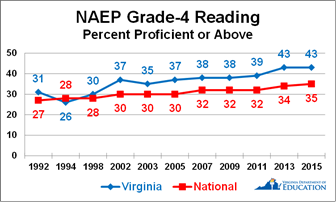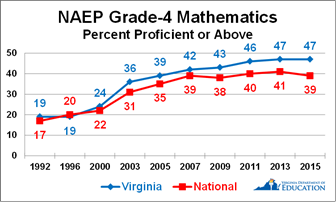Friday, January 29, 2016

The United States is at a crossroads. Either we continue to decline, or we focus on improving our schools so that we build the workforce required to become a nation of makers, again. The next few pages will outline the issue and the changes that must be made.
At the end of World War II, America had become the world’s leading manufacturing powerhouse, producing 50 percent of the world’s industrial output. Now the U.S. produces only a fifth of global manufacturing output. America was then the leader in quantity and quality of high school diplomas. Now the CFR's (Council on Foreign Relations) Renewing America initiative reports that the United States has slipped ten spots in both high school and college graduation rates over the past three decades.
This change is significant. The nation is now facing a critical “skills gap” between the number of talented professionals available and the number needed to lead manufacturing and design in America. Eighty-two percent of manufacturers surveyed by the Manufacturing Institute and Deloitte reported a moderate or serious shortage of skilled workers. By 2020, 65 percent of all jobs in the economy will require postsecondary education and training.
The Challenge of Graduating Literate Career-Ready Citizens
The numbers are clear. According to the 2015 National Assessment of Educational Progress (NAEP) Report, only 35 percent of the nation’s fourth-grade public school students can demonstrate reading skills at or above grade-level proficiency, while only 39 percent can demonstrate achievement at or above grade-level proficiency in mathematics.


There were no significant changes in the fourth-grade reading achievement gaps between white students and black and Hispanic students. Forty-six percent of white fourth graders performed at or above the proficient level, compared with 18 percent of blacks and 21 percent of Hispanics.
In 2014, according to a report by NAEP, only 39 percent of 12th-grade students had the mathematics skills and just 38 percent had the reading skills needed for entry-level college courses. Among not-enrolled youth who did not have high school diplomas, unemployment rates were 24.6 percent for men and 32.1 percent for women. Research shows that students who cannot read at grade level by the fourth grade are more likely than proficient students to drop out of school. Two-thirds will end up in jail or on welfare. Low literacy levels cost the U.S. $225 billion or more each year in non-productivity in the workforce, in crime, and in loss of tax revenue due to unemployment.
The challenges are not only at the K-12 level. In 2012 America ranked 16th in the number of 25–34-year-olds with college degrees, out of 26 developed nations. In the United States, 41 percent of first university degrees were awarded in social sciences, business, and law, whereas only 16 percent were awarded in science, mathematics, and engineering, one of the lowest percentages among the G-20 countries.
Yet, despite all the bad news, there is reason for optimism. Negative statistics hide the fact that some states are making significant improvement. Forty-three percent of Virginia’s grade-four students met or exceeded the national reading standard for proficiency. Students in Massachusetts performed at a statistically higher level in fourth-grade reading. In mathematics, 47 percent of Virginia fourth graders achieved at or above the proficient level. Fourth graders in Massachusetts and Minnesota performed at a statistically higher level.
Addressing Poor Literacy Outcomes
Make no mistake—reading at grade level by the end of third grade matters. It definitely affects the economy and the capacity of individuals to earn a living wage with a pathway into the middle class, which improves the economic prosperity of the nation.
Literacyhow reports that with investment in early childhood education, coupled with proven methods for early identification of struggling readers and research-based intervention, over 95 percent of public school students can be taught to read at grade level. ReadyNation reports that early learning programs for at-risk children can increase pre-reading skills by as much as 52 percent, which contributes to improvements in graduation rates by as much as 44 percent, and median earnings by as much as 36 percent. A study of an integrated PreK-3rd approach implemented in Chicago found improved educational outcomes leading to a long term societal return of $8.24 for every $1 invested in the first four to six years of school, including the Pre-K years.
Moving forward, the nation must focus on improving students’ reading skills at an early age. Reading is the foundational skill without which educational achievement, and the social and economic advancement that it makes possible, becomes unattainable.
The book titled Blueprint for a Literate Nation shows how everyone can help. It offers research-based recommendations that were reviewed and agreed upon at the Association of Manufacturing Excellence (AME) and Literate Nation Summit held in Williamsburg, Va., 28 September 2014. Some of the key findings:
Teachers’ knowledge of the subjects they teach is the major teacher characteristic related to student achievement.
Knowledge of how to teach reading makes a difference. The National Council on Teacher Quality found that 85 percent of the teacher education programs they surveyed ignored scientific research on reading.
Countless studies demonstrate that all but 1 percent of all students can be taught to read using proven and research-based methods.
Since 2003, Massachusetts has required teachers to pass a competency assessment in reading instruction and literacy. The state boasts the highest 4th- and 8th-grade NAEP scores in the U.S.
The nation must proactively identify struggling children at an early age and then have them taught by teachers who understand and are trained in the use of systematic, structured, regular, and intensive instruction in reading. All reading instruction must contain the five components of reading outlined in the National Reading Panel’s report (Phonemic Awareness, Phonics, Fluency, Vocabulary, and Comprehension). Teacher-training programs must also provide teachers with the knowledge of language and its structure, which is the basis for student success in learning to read (Moats, L.C., 2009).
Near-term solutions are available, like the Virginia Reading Corps (VRC), which provides children from age three through grade three with daily, one-on-one literacy intervention from trained, full-time instructors. Another successful program is the Minnesota Reading Corps, where 80 percent of struggling readers who participated passed the third-grade reading test.
Graduating Career-Ready Citizens for 21st-Century Success
While graduating from high school with adequate literacy skills is critical for long-term success, it is only one link in the chain that will result in America becoming a “Nation of Makers, Again.” The Association for Manufacturing Excellence (AME) has a vision for “A Manufacturing Renaissance driven by People Centric Leadership coupled with Enterprise Excellence.”
One of its key initiatives, Manufacturing a Desirable Career Path, is designed to help schools and colleges graduate on-time literate and skilled career-ready citizens who are equipped to join the workforce or continue in postsecondary education. AME’s Marshall Plan for “Becoming a Nation of Makers, Again,” coupled with its Adopt-a-School program on national Manufacturing Day, can do just that.
In a 2015 Manufacturing Day survey commissioned by The Manufacturing Institute and Deloitte, 90 percent of respondents indicated that the activities and tours were interesting and engaging; 84 percent indicated that the experience made them more aware of manufacturing jobs in their communities; 81 percent reported being “more convinced manufacturing provides careers that are interesting and rewarding”; and 62 percent reported being “more motivated to pursue a career in manufacturing.”
Virginia Governor Terence R. McAuliffe led the way in issuing a proclamation in support of coupling the AME Adopt-a-School program with Manufacturing Day. Williamsburg-James City County Public Schools (Virginia) was the first school district to deploy the program. The program enjoys the bipartisan support of Virginia’s Delegates Monty Mason and Brenda Pogge and Senators John Miller and Tommy Norment.
The Adopt-a-School program connects manufacturers with schools and colleges in their communities. It opens students’ eyes and gives them an opportunity to experience practical, hands-on learning and to help manufacturers give back to the community while helping grow the next generation of manufacturers.
AME is offering students the Dr. Sherrie Ford Manufacturing as a Career Path 2015–2016 Scholarship, which supports and promotes manufacturing as a career path by providing scholarship opportunities for next generation of manufacturing career-minded individuals.
“Cradle to Career-Ready” Approach to Education
Manufacturing companies can work with partners in the community to create a stronger pool of prospective candidates. Executives indicate that engaging early with local schools and colleges in science, technology, engineering, and mathematics (STEM) initiatives and skills certification programs can close the skills gap. Communities are now taking a “cradle to career” approach designed to graduate career-ready citizens by building ladders of opportunity for rewarding careers as shown below from the Literate Nation.

Recent developments point to a growing awareness of the importance of Career Technical Education (CTE) programs. The Evey Student Succeeds Act (ESSA) recently signed into law with bipartisan support contains many promising CTE-related provisions designed to improve alignment between state academic standards and state CTE standards and career guidance programs, and to increase focus on CTE student performance data. Sen. Tim Kaine (D-VA), co-chair of the U.S. Senate CTE Caucus, the original sponsor of many of these reforms, said, “CTE is an important pathway for students to prepare for the workforce by integrating practical applied purposes with work-based knowledge and a hands-on learning experience.”
Today there is a growing abundance of resources, organizations, and partnerships devoted to career education. The National Association of State Directors of Career Technical Education Consortium (NASDCTEc) is dedicated to the proposition that success in school and life comes from Career and Technical Education (CTE) programs—“Learning that works for America.”
NASDCTEc and the Center for Occupational Research and Development (CORD) have jointly published a book titled The Career Pathways Effect: Linking Education and Economic Prosperity, which offers guidance to states, local districts, postsecondary institutions, and business leaders on systemic improvement. The mission of the Pathways to Prosperity Network initiative of Jobs for the Future is to build “systems of career pathways linking high school, work, and community college, to increase the number of youth who complete high school and attain a postsecondary credential with labor market value.”
A proven model for Career Pathways is Newport News Shipbuilding’s an AME Corporate member whose partnership with Hampton Roads Public Schools (Virginia), through which students are mentored and given opportunities to experience future careers. This partnership provides a unique opportunity for the business to contribute directly to the school experience of the young people who are just beginning to formulate their dreams for the future. As this model shows, a partnership can take many forms and should be flexible enough to accommodate a wide range of activities by the business.
Schools and communities are learning to leverage programs like The Edge Factor, which produces story-driven media and supporting resources on eduFactor.org, to equip educators with tools designed to inspire and teach CTE, advanced manufacturing careers and technology, STEM, and more.
Project Lead The Way (PLTW) is a nonprofit organization that provides a transformative learning experience for K-12 students and teachers across the U.S. PLTW’s pathways in computer science, engineering, and biomedical science help students develop the in-demand knowledge and skills needed to thrive in an evolving world.
Tooling U-SME combines the strength of its industry leadership in training and development with SME’s dedication to promoting advanced technologies to manufacturers worldwide. According to its website, Tooling U-SME offers an “incredibly diverse suite of training resources that includes professional consultative services, online training content, instructor-led training, book and video content and industry-backed certifications. More than 210,000 individuals from 5,000 companies use [Tooling U-SME] to strengthen the knowledge and skills of their manufacturing workforce.”
These programs and initiatives are worth the effort. High-risk students are 8 to 10 times less likely to drop out in grades ten and eleven if they enroll in CTE programs instead of general programs. The average high school graduation rate for students concentrating in CTE programs is 90 percent, which is about 10 percent higher than the national freshman graduation rate. On average, 70 percent of CTE graduates enroll in postsecondary classes.
Manufacturing careers are lucrative. In 2013, the average manufacturing worker in the United States earned $77,506 annually, including benefits, while average compensation for workers in other industries was $62,546. On average, non-college-educated workers in manufacturing made 10.9 percent more than similar workers in the rest of the economy in 2012–2013.
The impact of advanced manufacturing is significant for economic prosperity. Manufacturing is by far the most important sector of the U.S. economy in terms of total output (Bureau of Economic Analysis 2014). It has a large “indirect employment multiplier.” For every person directly employed in manufacturing, manufacturing output supports more than 1.4 jobs elsewhere in the economy.
Community leaders and policymakers can leverage the Alliance for Excellent Education as it works to synthesize and distribute research and information about promising practices. It offers sound, objective, nonpartisan advice to make informed decisions about policy creation and implementation of new initiatives designed to graduate students ready for success in college, work, and citizenship.
Moving Forward – Becoming a Nation of Makers, Again!
Ending the dropout crisis requires an all-hands-on-deck approach. To ensure the class of 2020 reaches the goal of a 90 percent graduation rate, the Civic Marshall Plan Leadership Council established a phased approach with clear goals focusing on using evidenced-based strategies to address the dropout crisis.
One of the keys to America’s greatness is its ability to make things. As outlined in Manufacturing: A Blueprint for America’s Future, manufacturing brought our nation to unprecedented levels of prosperity. It carried us to victory in World War II and took our astronauts safely to the moon and back.
The story of advanced manufacturing in America continues to unfold. By working together, embracing, educational and economic strengths, and tackling challenges in a strategic manner as outlined in Building a Nation of Makers, a study grounded in history, we can help rebuild the “American Dream.” Together, We Can Do It!
Authors: Glenn Marshall, Association for Manufacturing Excellence (AME) at marsh8279@aol.com, Richard Long Ed.D., co-author Blueprint for a Literate Nation at richardlong1854@gmail.com, Richard Hinckley Ph.D. President/CEO Center for Occupational Research & Development (CORD) at hinckley@cord.org.


